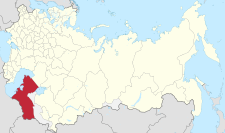Transcaspian Oblast
Transcaspian Oblast
Закаспійская область | |
|---|---|
 Расположение в Российской Империи | |
| Страна | Российская Империя |
| Генерал-губернаторство | Туркестан |
| Established | 1881 |
| Abolished | 1921 |
| Capital | Askhabad |
| Area | |
| • Total | 605,150.93 km2 (233,650.08 sq mi) |
| Population (1897) | |
| • Total | 382,487 |
| • Density | 0.63/km2 (1.6/sq mi) |
Закаспийская область , [ а ] или просто Закаспия , [ б ] была областью Российской империи и ранней Советской России к востоку от Каспийского моря во второй половине XIX века до 1924 года.
На юге оно было ограничено иранской провинцией Хорасан и Афганистаном с бывшей российской провинцией Уральск , а на северо-востоке - с бывшими российскими протекторатами Хивой , на севере - и Бухарой . Являясь частью российского Туркестана , оно примерно соответствовало территории современного Туркменистана и юго-западного Казахстана .
The name of the oblast (literally, 'Beyond [the] Caspian') is explained by the fact that until the construction of the Trans-Aral Railway in the early 20th century the easiest way to reach this oblast from central Russia (or from Russian Transcaucasia) was across the Caspian Sea, by boat from Astrakhan or Baku.

History
[ редактировать ]| History of Turkmenistan |
|---|
 |
|
|
Transcaspia was conquered by Russia in 1879–1885, in a series of campaigns led by Generals Nikolai Lomakin, Mikhail Skobelev, and Mikhail Annenkov. The construction of the Transcaspian Railway was started from the shores of the Caspian in 1879 in order to secure Russian control over the region and provide a rapid military route to the Afghan border. In 1885 a crisis was precipitated by the Russian annexation of the Panjdeh oasis, to the south of Merv, which nearly led to war with Britain, as it was thought that the Russians were planning to march on to Herat in Afghanistan.[1] Until 1898 Transcaspia was part of the Governor-Generalship of the Caucasus Viceroyalty administered from Tiflis,[2] but in that year it was made an oblast of Russian Turkestan governed from Tashkent. The best known military governor to have ruled the region from Ashkhabad was probably General Kuropatkin, whose authoritarian methods and personal style of governance made the province very difficult for his successors to control. Consequently, the administration of Transcaspia became a byword for corruption and brutality within Russian Turkestan, as Russian administrators turned their districts into petty fiefdoms and extorted money from the local population.[3] These abuses were fully exposed by the Pahlen Report of 1908–1910.
During the revolutionary period of 1917 to 1919, parts of Transcaspia were briefly occupied by British Indian forces from Meshed. The oblast was one of the last centres of Basmachi resistance to Bolshevik rule, with the last of the rebellious Turkmen fleeing across the border to Afghanistan and Iran in 1922 and 1923.
Demographics
[edit]As of 1897, 382,487 people populated the oblast. Turkmens constituted the majority of the population, and significant minorities were Kazakhs and Russians. The total Turkic-speaking population was 328,059 (85.8%).
Ethnicity
[edit]Overall
[edit]According to the 1897 Russian census, the ethnic groups by population were:[4]
| Ethnic group | Population | Percentage |
|---|---|---|
| Turkmens | 248,651 | 65% |
| Kazakhs | 74,225 | 19.4% |
| Russians | 27,942 | 7.3% |
| Persians | 8,015 | 2.1% |
| Total | 382,487 | 100% |
By okrug
[edit]Ethnic groups by percentage of the Transcaspian population according to the 1897 census:[4]
| Okrug (district) | Turkmens | Kazakhs | Russians | Persians |
|---|---|---|---|---|
| Ashgabat | 73.1% | - | 12.8% | 3.3% |
| Krasnovodsk | 62.4% | 19.3% | 9.7% | 3.4% |
| Mangyshlak (centred on Fort-Aleksandrovsk) | 4% | 93% | 2.6% | - |
| Merv | 88% | - | 4.5% | 0.8% |
| Tejen | 82% | - | 7.9% | 4.1% |
| Total | 65% | 19.4% | 7.3% | 2.1% |
Ethnic groups by population in Transcaspia according to the 1897 census:[4]
| Okrug | Turkmens | Kazakhs | Russians | Persians |
|---|---|---|---|---|
| Ashgabat | 67,443 | 22 | 11,763 | 3,206 |
| Krasnovodsk | 33,529 | 10,394 | 5,222 | 1,822 |
| Mangyshlak | 2,767 | 63,795 | 1,795 | 6 |
| Merv | 104,980 | 11 | 5,321 | 964 |
| Tedjen | 39,932 | 3 | 3,841 | 2,017 |
| Total | 248,651 | 74,225 | 27,942 | 8,015 |
Notes
[edit]References
[edit]- ^ Г. Н. Керзон Россия в Средней Азии (Лондон: Longmans) 1889, стр. 1-15.
- ^ Александр Моррисон (1 сентября 2008 г.). Русское правление в Самарканде 1868-1910 гг.: сравнение с Британской Индией . ОУП Оксфорд. п. 20. ISBN 978-0-19-954737-1 .
- ^ Ричард А. Пирс, Российская Центральная Азия, 1867-1917 (Беркли: University of California Press), 1960, стр. 88-9.
- ^ Перейти обратно: а б с "Справочник статистических показателей" [Handbook of statistical indicators]. Demoscope Weekly – Application (in Russian).
- Kropotkin, Peter Alexeivitch (1888). . Encyclopædia Britannica. Vol. 23 (9th ed.). pp. 511–513.
- Кропоткин, Петр ; Билби, Джон Томас (1911). . В Чисхолме, Хью (ред.). Британская энциклопедия . Том. 27 (11-е изд.). Издательство Кембриджского университета. стр. 170–172.

